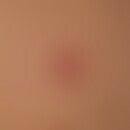DefinitionThis section has been translated automatically.
LCE3B (Late Cornified Envelope 3B) is a protein-coding gene located on chromosome 1q21.3. The encoded LCE3B protein is a structural component of the cornified envelope of the stratum corneum. The protein has defensin-like antimicrobial activity against a broad spectrum of Gram-positive and Gram-negative bacteria, both aerobic and anaerobic species. In inflammation, it potentially regulates skin barrier repair by influencing the composition of the cutaneous microbiota and the immune response to bacterial antigens (Niehues H et al. 2017).
General informationThis section has been translated automatically.
Terminally differentiating epidermal keratinocytes express a large number of structural and antimicrobial proteins that are involved in the physical barrier function of the stratum corneum and provide innate cutaneous host defense. The late cornified envelope (LCE) genes, located in the epidermal differentiation complex on chromosome 1, encode a family of 18 proteins of unknown function whose expression is largely restricted to the epidermis.
Thus, deletion of two members, LCE3B and LCE3C (LCE3B/C-del) has been shown to be a common psoriasis risk factor that interacts with the major psoriasis risk gene HLA-C*06. LCE3A is directly adjacent to LCE3B/C is functionally linked to it. LCE3B/C-del is associated with markedly increased expression of LCE3A.
ClinicThis section has been translated automatically.
Diseases associated with LCE3B include psoriasis
LiteratureThis section has been translated automatically.
- Niehues H et al (2017) Psoriasis-Associated Late Cornified Envelope (LCE) Proteins Have Antibacterial Activity. J Invest Dermatol 137:2380-2388.
- Song GG et al. (2013) Association between the LCE3C_LCE3B deletion polymorphism and susceptibility to psoriasis: a meta-analysis of published studies. Genet Test Mol Biomarkers 17:572-577.



